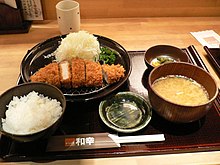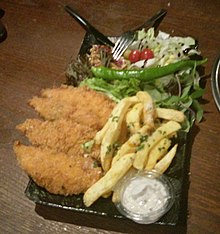Schnitzel
Breaded schnitzel is popular in many countries and is made using veal, pork, chicken, mutton, beef, or turkey.The English term schnitzel means in general all types of breaded, fried flat pieces of meat.A majority of the restaurants in Windhoek, Walvis Bay, and Swakopmund offer it on their menus, often topped with a fried egg and accompanied by potato salad.[5][6][7] It was originally considered a type of yōshoku—Japanese versions of European cuisine invented in the late 19th and early 20th centuries—and was called katsuretsu (cutlet) or simply katsu.In Korean cuisine, pork (donkaseu, from Japanese tonkatsu), chicken (chikinkaseu), and beef (bipkaseu) cutlets are popular.Wiener schnitzel, a very thin, breaded and pan fried cutlet made from veal, is one of the best known specialities of Viennese cuisine, and is one of the national dishes of Austria.Called шницел (shnitsel), it is made from ground veal, formed as a thin patty, seasoned with salt and black pepper, then breaded and fried.It is common at truck stops, and it is usually ordered à la carte, coming with a lemon wedge, but one can also find it in the frozen sections in supermarkets or premade and ready to cook.Some restaurants offer the cordon bleu variant, a slice of schnitzel rolled and filled with cheese and ham.In the Republic of North Macedonia, the dish called шницла (shnitzla) is a piece of pork seasoned with salt and black pepper, breaded and fried.In Russia, the dish is called отбивная (otbivnaya), which literally means a piece of meat that has been beaten, although the name шницель (šnitselʹ) is also in use.In Slovenia, a schnitzel filled with ham and cheese, breaded and fried (cordon bleu) is called ljubljanski zrezek (after Ljubljana, the country's capital).San Jacobo (commonly) or cachopo (in the region of Asturias) is usually made with veal or pork stuffed with ham and cheese.Also the "Walliser Schnitzel" is a variant in which the meat is not breaded, but is fried in oil and then coated with tomato sauce and raclette cheese.In West Ukraine (former Habsburg Kingdom of Galicia and Lodomeria), it is known as шніцель shnitsel′; in the rest of the country, it is called as відбивна vidbyvna, also bytky [uk].Thought to have been introduced in Persia during the World Wars, shenitsel is usually thicker, bigger, spicier, and fried with a more crispy breading than the standard schnitzel.The meat is typically chicken or turkey breast, in conformance with dietary kashrut laws, which prohibit pork.Additionally, vegetable oils are used for frying, as clarified butter, the preferred cooking fat for Austrian Wiener schnitzel, is impermissible for kosher use alongside meat.Before frying, the schnitzel is coated with a mixture of beaten eggs and bread crumbs, sometimes spiced with paprika or sesame seeds.It is usually served with mashed potatoes, French fries, rice, or pasta, accompanied by ketchup, hummus, or vegetable salad.During the early years of the state of Israel, veal was not obtainable, and chicken or turkey proved to be inexpensive and tasty substitutes.Some frozen schnitzels are breaded patties made from processed chicken or turkey meat, not whole poultry breasts.Schnitzel is also sold in a pita, alongside hummus, French fries and vegetable salad, in a similar way to falafel.In northern Baja California, Sonora, Sinaloa, and Chihuahua (due to U.S. influence), it features lettuce, tomato, and mayonnaise like a traditional sandwich, but the milanesa is also common in these regions as the main course of a meal.In Argentina, Paraguay and Uruguay, this dish, called milanesa, consists of a thin slice of beef, chicken, veal, or sometimes pork, and even eggplant or soy.In Brazil, such preparations, designated à milanesa (Milanese-style), are quite common, especially in the more European-influenced southern region of the country.











Snitzel (horse)Schnitzel (disambiguation)Main courseAustriaCentral EuropeBreadingmeat tenderizerbreadedchickenmuttonturkeywiener schnitzelMiddle High GermanAustrianViennese dishpotato saladparsleybutterescalopeFrenchSouth Africatonkatsucurry and riceyōshokuEuropean cuisinecutletchicken katsumenchi-katsuKorean cuisineViennese cuisineJägerschnitzelzigeuner saucebell peppersBosnia and HerzegovinaGermanblack pepperCroatiancordon bleuCzech RepublicDenmarkDanishcapershorseradishanchovyEstoniaFinlandSecond World WarBéarnaise saucePariser schnitzelcutletsSchnitzel Wiener ArtJagdwurstnokedliAustro-HungarianHungaryscaloppineKotlet schabowyRussiaRussian cuisineSerbiaSlovakiaAsturiasflamenquínCórdobaSwedenanchoviesspratsracletteKingdom of Galicia and LodomeriaMiddlesbroughTeessidetake-away foodbreaded cutletbéchamel saucecheddar cheesePersianPersiaIsraelHebrewIsraeli cuisineturkey breastkashrutvegetable oilsclarified butterkosherpaprikasesameketchuphummusvegetable saladAshkenazi Jewscorn schnitzelsFrench friesfalafelLebanonCanadaMexicomilanesabolilloBaja CaliforniaSonoraSinaloaChihuahualettucetomatomayonnaisetortillagrated cheeserefried beanslettuce saladpork tenderloin sandwichChicken-fried steakAustraliatake-awayparmigianaItalian tomato sauceBrazilMilaneseColombiaValle del CaucacheeseVal d'AostaChicken KievRiver PlateHainanesepork chop